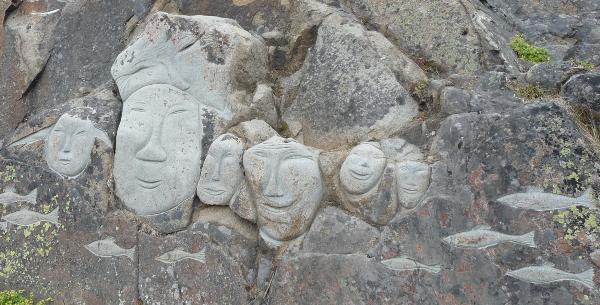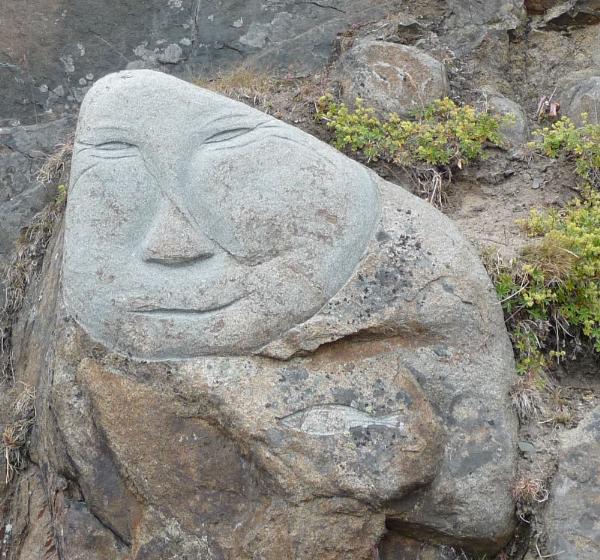In 1993 and 1994, Qaqortoq (Kakortok) was visited by 18 Nordic artists who launched a project called "Stone & Man". Today, these fantastic stone works of art decorate the town. Aka Høegh, who is one of Greenland's leading artists, came up with the idea for the stone sculptures and it is thanks to her that we now have more than 30 of these outdoor works of art around the town.

Some of the sculptures are freestanding stones, while others are in rock formations around this Greenland city.
To claim a find for this cache:
1. Read the information below about Greenland geologic rock formations.
2. Required - a photo of yourself at the posted coordinates in front of the rock face carving of many whales, “They Come” by Aka Høegh from Greenland. This must be attached to your found log. If you are camera shy, write your name and date on a piece of paper and photograph it in front of the carving.
3. Answer the following:
-which type of rock is predominant in this area?
-as you explore, look for intrusions in the rocks and/or lichens growing on the rocks. Select one of them and describe in detail - color, texture, shape, location. (Note about lichens - if it's soft, green, or has flowers, it's not a lichen.) You may want to look up what an intrusion or a lichen is before answering.
4. Finds without a personalized photo attached, or answers sent will be deleted after 24 hours. If the answers will be sent when you get home, state the date I can expect them in your found log. My responses will be through the message center.
GREENLAND GEOLOGY
Greenland is the world’s largest island. The average depth of the ice cap is 5000’ and 10,000' at the deepest. The predominant rock in this area is 1750 million years old. Occasional black volcanic rocks poke through are estimated to be more than 3 billion years old. In Eastern Greenland, the youngest part of the island, there are three different, basic groups of rocks.
1. Sediments
A sediment comes into existence when pieces of rock are deposited at the surface of the Earth - be it on dry land or in the water. Wind may blow a sand dune together, gravel is deposited by a river, fine mud is deposited in a lake, a glacier carries large boulders together to form a moraine: in each case, bits and pieces of rocks are brought together. There are countless types of sediment with different properties: they have different color, ability to resist erosion or to store water, gas or oil etc. Sediments often have a clearly visible layering, which is usually horizontal unless they have later been deformed. The lowest layers are the oldest ones.
The above examples are all 'clastic' sediments. In all cases, pieces of rock ('clasts') have been eroded somewhere and brought together somewhere else. There are still other types of sediment: biogenic and chemical ones.
An important biogenic sediment is limestone in most of its many variations. It can originate from a coral reef or by slow deposition from calcareous shells from mussels or algae. Another important biogenic sediment is coal, which is derived from vegetation over various stages such as peat and brown coal.
Examples for chemical sediments are gypsum and halite (salt). Both come into existence, when lagoons evaporate and the water is not being replaced sufficiently. Also, some variations of limestone may originate from inorganic processes, without involving organisms.
All sediments have in common that they come into existence at the surface of the Earth (including the sea floor).
2. Magmatic rocks or magmatites (rocks derived from melting)
The origin of every magmatic rock is molten rock mass. For the result, the kind of rock that was molten is an important factor, as it provides the chemical material that can then be re-used. Simplified, there are 'acidic' magma types that are similar to granites and 'basic' ones that chemically resemble basalt. The terms 'acidic' and 'basic' do not have anything to do with the pH value, but with the amount of silica (SiO2): the more silica, the more 'acidic'. Acidic lava (magma which has reached the surface) tends to be very viscous, but other factors such as temperature, content of fluids (water, CO2 and others) also play an important role.
Most magmas cool down way below the surface to form Plutonites; large rock bodies such as granite that can comprise many km3.
Sometimes, smaller volumes of molten rocks fill weak zones such as cracks within the pre-existent rocks, forming so-called intrusions. Basaltic intrusions are common in many areas and are visible as dark stripes.
If magma comes to the surface, a volcanic eruption will be the result. There is a large number of different eruption mechanisms and an endless choice of rocks that can be formed as a result; they are collectively called volcanites or, simply, lava.
3. Metamorphic rocks or metamorphites (rocks changed due to heat and/or pressure)
If rocks are exposed to strong heat or pressure or even both at the same time, then they will be changed, regardless of their original composition. The chemistry remains the same, as there is nothing added or removed, but the available material is re-organized to form new crystals of different minerals, in the same way as oven heat can turn dough into cake (or coal...). This process is called metamorphosis, and the resulting rocks are metamorphites or metamorphic rocks. For the result, the original kind of rock plays an important role, although it can be difficult to determine if metamorphosis has been strong.
If hot magma intrudes into cold rocks, then these will become quite hot. They will recrystallize in the contact zone, which is often obvious on both sides of basaltic intrusions.
If rocks get between colliding plates, then they will experience extreme pressure and thus metamorphose. A typical rock for such a situation is gneiss. With other words: when continents collide and mountain chains form, then under the mountains, in depths of several kilometers, there will be a wide gneiss area.
When the mountains are eventually worn down by erosion, the gneiss core will be exposed at the surface and tell the geologist that mountains must once have been there, although the landscape may have been eroded down to the level of table-flat lowlands at sea level. Geologically, such a recycled plateau is a mountain chain in two ways: the gneiss core of the old mountains, which have been eroded for a long time and which now gives witness of an ancient mountain chain. This will usually be called 'fold belt'. And then the young mountain chain, which is one in a stricter sense with mountain peaks, valleys etc, everything made up of old, 'recycled' rocks. This is an important principle in geology: everything will be recycled again and again, nothing really disappears, rocks just change their appearance, location, composition etc. The geological system 'Earth' works in circles: the rock circle. Molten rock comes to the surface to cool down and form lava. This is then eroded and deposited again somewhere else as sediment. Tectonic processes bring it back into the deep layers of the crust, where it can be metamorphosed, then it is gneiss. This can finally melt and the whole process can start all over again, with one of its countless variations.
Most rocks that we see exposed at the surface have gone through this rock cycle already many times. Sometimes, the youngest process which affected the rocks is the only one which left its traces, as older ones were wiped out at the same time, but sometimes rocks have preserved traces of several generations of rock-forming processes and thus make it possible to reconstruct Earth history.
Should such a flat lowland area experience uplift again, the result will be a high plateau to begin with. This will then be dissected by erosion: glaciers and rivers create valleys that incise into the plateau. Mountains will remain between the valleys for a while.
